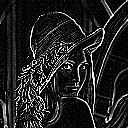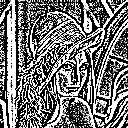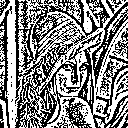 Fred's ImageMagick Scripts
Fred's ImageMagick Scripts
Copyright © Fred Weinhaus My scripts are available free of charge for non-commercial (non-profit) use, ONLY. For use of my scripts in commercial (for-profit) environments or non-free applications, please contact me (Fred Weinhaus) for licensing arrangements. My email address is fmw at alink dot net. If you: 1) redistribute, 2) incorporate any of these scripts into other free applications or 3) reprogram them in another scripting language, then you must contact me for permission, especially if the result might be used in a commercial or for-profit environment. Usage, whether stated or not in the script, is restricted to the above licensing arrangements. It is also subject, in a subordinate manner, to the ImageMagick license, which can be found at: http://www.imagemagick.org/script/license.php Please read the Pointers For Use on my home page to properly install and customize my scripts. |
|
Generates high pass or low pass filtered images based upon convolution kernels whose weights are derived from the binomial coefficients. |
last modified: December 15, 2018
|
USAGE: binomial [-w width] [-t type] [-m mix] [-b bias] infile outfile
-w ...... width .... width of square filter; width=3, 5 or 7; default=3 PURPOSE: To generate high pass or low pass filtered images based upon convolution kernels whose weights are derived from the binomial coefficients. DESCRIPTION: BINOMIAL generates an output image which is a user defined mix or blend of the original image and a binomial convolution filtered version of the image. This is achieved by forming a single convolution kernel whose weights depend upon a mixing of the binomial coefficients and the identity kernel. The basic blended low pass filtering formula is F = (1-m)*I + m*B, where I is the original image, B is the binomial filtered image and m = mix/100. When m=0, we get only the original image and when m=1, we get only the low pass binomial filtered image. For intermediate value of m, we get a blend of the image and the binomial low pass filtered image. Now, we can consider both I and B as a convolution of some kernel with the original image, namely I = i x I and B = b x I, where x means convolution. Note that a convolution is simply a weighted average of all the pixels in some neighborhood of a give pixel. Usually an odd sized neighborhood, such as 3x3, 5x5, etc is used to prevent having the resulting image be shifted a fractional pixel. The convolution kernel values are simply the weights for the average. So here, i is the identity kernel, which is all zeroes, except the center of the kernel which has a value of 1. Similarly, b is the binomial kernel, formed from the binomial coefficients as a 2D kernel. It is one form of a low pass filter. Thus we can consider the final filtered image, F = f x I, where f = (1-m)*i + m*b. Consequently, we only have to do one convolution using the convolution kernel, f. For high pass filtering, we form the high pass filter by subtracting the low pass filter from the original image. Thus in the formula above B is replaced by (I-B), so that F = (1-m)*I + m*(I-B). But likewise this can be converted into one convolution kernel, namely, f = i - m*b. Note, that properly, all convolution kernels, must be normalize so that the sum of weights is equal to 1, except for pure high pass filter convolution kernels, whose weights must sum to 0. The normalization to 1 is needed to keep the overall brightness of the image unchanged. However, as IM does the normalization automatically, you will notice that my binomial and blended convolution kernels have weights that do not sum to 1. This allows the convolution kernel weights to be presented primarily as easily read integers. So in order to compensate for the un-normalized binomial convolution kernel in order to keep the two components properly balanced, the two formulae become: f = s*(1-m)*i + m*b for the low pass filter kernel and f = s*i - m*b for the high pass filter kernel, where s is the sum of the weights for the un-normalized binomial kernel b. For width=3, the 1D binomial series is 1 2 1. For width=5, the 1D binomial series is 1 4 6 4 1. For width=7, the 1D binomial series is 1 6 15 20 15 6 1. To form the 2D binomial filters, the outer product of the 1D column with the 1D row is computed.
For width=3, this becomes:
For width=5, this becomes:
For width=7, this becomes:
For more information about the binomial coefficients, see Pascal's Triangle. ARGUMENTS: -w width is dimension of a square convolution kernel. Width can be 3, 5 or 7. the default is 3. For example a width of 3 will generate a 3x3 convolution kernel. -t type is the kind of filter, either a high pass or low pass filter. Thus type=high or low. The default=high. A low pass filter will cause blurring. A high pass filtered image will produce either sharpening or it will extract edges. See below. -m mix is the percentage mixing factor to use to blend the filtered result with the original image. A value of mix=0, results in the original image. A value of mix=100 results in a pure high pass or pure low pass filtered image. For low pass filtering, a larger value for mix will produce more blurring. For high pass filtering, a middle value will produce sharpening of the edges in the image; whereas a value of 100 will extract the edges from the image. -b bias is a percentage to brighten or darken the image. Values for bias are integers ranging from -100 to 100 (percent). Positive values will brighten the image and negative values will darken the image. CAVEAT: No guarantee that this script will work on all platforms, nor that trapping of inconsistent parameters is complete and foolproof. Use At Your Own Risk. |
|
Low Pass Filtering Of A True Color Image | ||||
|
Original Image |
Arguments: |
Arguments: |
Arguments: |
Arguments: |

|

|

|

|

|
|
2D Kernel |
2D Kernel |
2D Kernel |
2D Kernel |
2D Kernel |
|
High Pass Filtering Of A True Color Image |
|||
|
Original Image |
Arguments: |
Arguments: |
Arguments: |

|

|

|

|
|
2D Kernel |
2D Kernel |
2D Kernel |
2D Kernel |
|
Edge Extraction From A Grayscale Image |
|||
|
Original Image |
Arguments: |
Arguments: |
Arguments: |

|

|

|

|
|
2D Kernel |
2D Kernel |
2D Kernel |
2D Kernel |
|
Filtering With Bias | |||
|
Original Image |
High Pass |
High Pass Lightened |
High Pass Darkened |

|

|

|

|
|
Original Image |
Low Pass |
Low Pass Lightened |
Low Pass Darkened |

|

|

|

|
|
What the script does is as follows:
This is equivalent to the following IM commands for
|